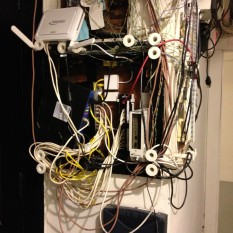
Note: If you’d like to share this post, this is the shortened link: http://bit.ly/AlterCreative
If we want to move forward, we need to recognize where we are currently standing, and adapt our behavior to the reality we encounter.
Warning: Such recognition, often makes people think everything is getting worse. That simply is not true; that is just nostalgia playing havoc with your perception. There never were good old days because back then people still needed to find best practices too. They did not know then what you know now, just as those coming down the pike will have full benefit of all your excavation tomorrow. So be it.
So…
- This is an Era of Grand Abundance. There are more things to do than ever before. Everything is competing for increasingly limited available leisure time. As many of 50,000 feature film titles are generated on a worldwide basis annually. Good movies don’t get seen.
- Movies are not the dominant option for leisure time activities for most people. Physical & outdoor recreation, online & video games, live events, and many other wonderful options compete on an equal playing field for consumer’s available time and money.
- The past competes with the present as never before. We have better access to content created decades ago than those that were living when it was being created. The past has been evaluated more widely or deeply than we can hope the present to be, making it easier to be discovered and connected with.
- Content accessibility is no longer an inverted pyramid ending at a blocked spigot, but an open flow of rapidly moving particles with little to grab hold to. The abundance of content is matched by a complete accessibility to it, anytime, anywhere, on any device. The options are endless. There are no barriers to distribution, only to awareness and engagement.
- Audiences feel overwhelmed. Everyone everywhere is distracted, deafened by the noise, blinded by the glare. Audiences no longer know how to discover work that they will most likely respond positively to. We could be digging ourselves deeper into a very deep hole, as we are prone to engage less frequently with that thing when we don’t get the results we desire.
- Our available time is more limited than ever before. People work more. They have more on their agenda. They have more options than before. Less and less becomes spontaneous.
- The long tail is crushed by the weight of the herd of the new, buried under the tsunami of the now that is constantly being generated.
- People crave the authentic. In the age of both mechanical and digital reproduction, we tend to increasingly value that which can not be recreated. In an overt consumerist environment, we also start to cherish that which does not need to be sold.
- If most things can be time-shifted, delayed, and recorded for later consumption, events that are one-of-a-kind and fleeting are increasingly valued.

10. The old tools and practices no longer work, but we are prone to get in a rut of habit, doing the same things, expecting to get past results that stopped occurring long ago. Newspapers and their influence have decreased, reducing cost effective options for audiences to discover movies. Even email and social media seem to have less impact than they used to.
11. Although we have access to more, we discover less. Online, we get stuck in echo chambers of community thought, and have lost serendipitous discovery of the past. We are expansive beings with diverse taste, but we get stuck in ruts of habit. The film business lost its year-round curators when the newspaper business collapsed and film critics lost their job. Newspapers were engines of serendipitous discovery.
 12. The vast connectivity we have — due to the internet and communication revolution — changes everything, including our art & commerce. Information & opinions can spread faster than we ever imagined. We don’t live in story beats the way we once did or even still dream we do. The present becomes a spontaneous sensation as opposed to events with discernable steps towards it. The narrative of daily life is growing more evasive. The surrounding volume intensifies. Do we have a choice other than adapting?
12. The vast connectivity we have — due to the internet and communication revolution — changes everything, including our art & commerce. Information & opinions can spread faster than we ever imagined. We don’t live in story beats the way we once did or even still dream we do. The present becomes a spontaneous sensation as opposed to events with discernable steps towards it. The narrative of daily life is growing more evasive. The surrounding volume intensifies. Do we have a choice other than adapting?
13. We are reminded of our vulnerability more often and more deeply. Whether it was 9/11/00 or 9/15/08, terrorism and economic collapse influence our decisions and actions in more ways than we probably realize. We expect something equally traumatizing on the horizon. It is not a land of plenty, but one where the precious might be taken at any juncture.
14. Art, audiences, technology, & business change far faster than markets or industry. There is tremendous opportunity in this gap for new business and new forms of creation. The First Mover Advantage is there for our taking.
15. People – and communities — generally only change their behavior when the pain of the present exceeds their fear of the future. When it comes to the film business, it is reasonable to assume we have come upon a moment of mandated change.
16. People (i.e. Audiences) want greater return on the investment of their engagement than ever before. Americans in particularly expect to exchange their leisure time for intellectual capital, which transforms into social capital. We expect to improve ourselves by our consumption practices.
17. On a personal level, all industries are about people keeping their jobs. They won’t do something that will risk them losing their job. In the film biz, often the way to keep your job, is to not make a movie, particularly one that does not have universal support.
18. We have more ways — and thus more opportunities — that we can work collaboratively than ever before. We don’t have to be in the same place. We don’t need to see or understand the results. We can gather information that will be analyzed later. We can all harness the power of many that once was only the domain of the super powerful.
19. Although we are working longer hours at higher level jobs than ever before, due to the nature of our available technology, we have more usable time that we can use to work together to get fast results. Even collaborating remotely, we can see the results quickly.
What have I left off? Surely there are some things you can share.
Next week, I will offer what I feel we should do in face of the realities of the film business and culture today. I feel that there are certainly best practices that enable us to have a sustainable creative life.
See also: 17 Things About The Film Biz That Should Significantly Alter Your Behavior
Update: This post originally began with:
Last week at The San Francisco Film Society we launched A2E (Artist To Entrepreneur), a specific line of programming designed to provide filmmakers with the necessary entrepreneurial skills and best practices needed to have a sustainable creative life. We launched with A2E OnRamp, a workshop to allow filmmakers to budget, schedule, and predict possible revenues for their film throughout the direct distribution process.
Before we rolled up our sleeves to start the practical, I warmed up the crowd with a series of short lectures focusing on what all filmmakers should know about the film biz, the current culture, and recommended best practices for themselves. Last week I shared with you what we discussed about the film business. Today, I offer you my rumination on culture in general. Like the post on the film business, it is easy to dismiss this as generally negative. That simply is not true; that is nostalgia playing havoc with your perception. There never were good old days because back then people needed to find best practices too. They did not know then what you know now, just as those coming down the pike will have full benefit of all your excavation tomorrow. So be it.
I have removed it so it can be more “timeless”.





